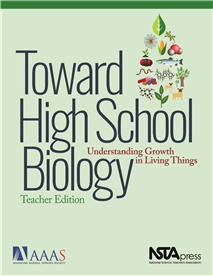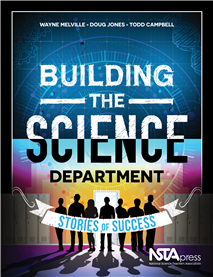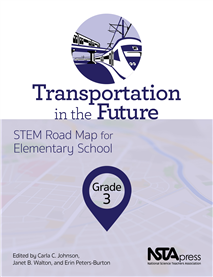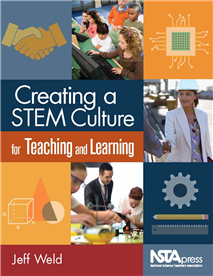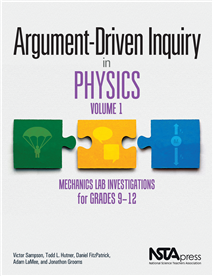All Book Chapters
Book Chapter
Scientists and Engineers USE MODIFICATION (Grades 3–5)
In this lesson, students learn that scientists and engineers use modification. They read Papa’s Mechanical Fish, a historical fiction book based on the inventive work of Lodner Phillips. After reading, students design a boat using specified materia...
Book Chapter
Scientists and Engineers USE IDEA DEVELOPMENT (Grades 3–5)
In this lesson, students learn that scientists and engineers use idea development. They read the book What Do You Do With an Idea? After reading, students learn about brainstorming and the design process. This selection highlights how scientists and ...
Book Chapter
Scientists and Engineers USE DESIGN PROCESS (Grades 3–5)
In this lesson, students learn that scientists and engineers use design process. They read the book Rosie Revere, Engineer. After reading, students create a concept map of the design process after learning about the challenges that book character Ros...
Book Chapter
Would you like to challenge your middle school students to explain a range of phenomena—from how nylon thread can form from two clear, colorless liquids to how a snake that eats only eggs can make body structures such as skin and scales that don’...
Book Chapter
Building the Science Department: Stories of Success (Book Sample)
How can your science department become a site for developing science teachers’ professional learning? Building the Science Department answers that question through stories from teachers who walk the sometimes rocky path of reforming science teachin...
Book Chapter
Transportation in the Future, Grade 3: STEM Road Map for Elementary School (Book sample chapter)
What if you could challenge your third graders to design the train of the future? With this volume in the STEM Road Map Curriculum Series, you can! Transportation in the Future outlines a journey that will steer your students toward authentic pro...
Book Chapter
This lesson introduces students to the module and the culminating challenge for the module—the Maglevacation Train Challenge. The focus is on train travel, and it’s helpful to access students’ prior experiences and current understanding and per...
Book Chapter
This lesson provides information to enable students to identify the connection between the westward expansion of the United States and the proliferation of train travel. Students are also introduced to information about the railway engineers who are...
Book Chapter
In this lesson, students explore passenger train travel today and compare it with other modes of transportation, using the jigsaw learning method. They explore electromagnets and identify independent and dependent variables and formulate hypotheses. ...
Book Chapter
Speeding Ahead–The Maglevacation Train Challenge
In this lesson, students apply their knowledge of mapping, geography, trains, and science concepts related to magnetism and speed to design their Maglevacation Trains. Each student team will design and build its train and prepare a video presentation...
Book Chapter
This chapter highlights the story of STEM. There is a moral and economic underpinning to the STEM imperative. Anything short of the cultivation of a culture for STEM is insufficient. Success requires a systemic rather than a piecemeal approach to STE...
Book Chapter
Catalyzing Professional STEM Networks: Local, Regional, and Statewide
This chapter presents the essential role of networks—intra- and inter-school and cross-stakeholder alliances—for effective, sustainable STEM education. The journalist’s principle of the Five W’s leave no stone unturned regarding networks: Wh...
Book Chapter
School—Business STEM Partnerships
A signature of the STEM awakening has become the school–business connection. What was once the sole domain of career-technical education, workplace applications of content, and on-the-job learning permeate the core disciplines of math and science i...
Book Chapter
STEM Teachers, STEM Classrooms, STEM Schools
Over the course of the early 21st century, STEM has enjoyed a bandwagon effect as the brand strengthens. In this chapter, purists and pioneers have put structures in place to establish a certain standard that upholds important labels such as STEM tea...
Book Chapter
Interwoven with classroom and teacher designations are curricula and assessment strategies. This chapter profiles some of the exemplary materials that support STEM teaching and learning, as well as the emergent process of homegrown school–business ...
Book Chapter
There are teachers of STEM subjects and then there are STEM teachers. This chapter distinguishes the two, highlighting preparatory programs and pathways that integrate the best practices illuminated up to this point into the minting of a professional...
Book Chapter
The Professional Development of STEM Teachers
This chapter examines the challenges inherent in helping content area secondary teachers and generalist elementary teachers implement a STEM learning mission. Building capacity for STEM intricately involves transforming teachers of mathematics, scien...
Book Chapter
This chapter is the result of answered invitations for experts across the STEM stakeholder spectrum to weigh in on where we go from here. Classroom practitioners, industry advocates, community catalysts, parents, elected officials, and interested bys...
Book Chapter
The purpose of this lab is to introduce students to the core idea of forces and motion by having them explore the relationship between acceleration and velocity to determine ”How Does the Direction of Acceleration Affect the Velocity of an Object?�...
Book Chapter
The purpose of this lab is to introduce students to the core idea of forces and motion by having them explore ”What Is the Relationship Between the Mass of an Object and Its Acceleration During Free Fall?” The Teacher Notes provide the connection...
Book Chapter
The purpose of this lab is to introduce students to the core idea of forces and motion by having them explore projectile motion and determine ”How Do Changes to the Launch Angle, the Initial Velocity, and the Mass of a Projectile Affect Its Hang Ti...
Book Chapter
The purpose of this lab is for students to apply what they know about the core idea of forces and motion to determine ”How Do the Direction and Rate of Rotation of a Spinning Surface Affect the Path of an Object Moving Across That Surface?” The T...
Book Chapter
The purpose of this lab is to introduce students to the core idea of forces and motion by having them determine ”What Is the Mathematical Relationship Among the Net Force Exerted on an Object, the Object’s Inertial Mass, and Its Acceleration?” ...
Book Chapter
The purpose of this lab is to introduce students to the core idea of forces and motion by having them explore ”How Does the Mass of the Counterweight Affect the Acceleration of a Pulley System?” The Teacher Notes provide the connections to standa...
Book Chapter
The purpose of this lab is to introduce students to the core idea of forces and motion by having them explore ”What Is the Mathematical Relationship Between the Angle of Incline and the Acceleration of an Object Down the Incline?” The Teacher Not...
Book Chapter
The purpose of this lab is to introduce students to the core idea of forces and motion by having them determine how different types of oils change the coefficient of kinetic friction between two metal plates to explain ”Why Are Some Lubricants Bet...
Book Chapter
Falling Objects and Air Resistance
The purpose of this lab is for students to apply what they know about the core idea of forces and motion to determine ”How Does the Surface Area of a Parachute Affect the Force Due to Air Resistance as an Object Falls Toward the Ground?” The Teac...
Book Chapter
The purpose of this lab is to introduce students to the core idea of forces and motion by giving them an opportunity to explore factors that affect the rotation of an object to determine ”How Do the Mass and the Distribution of Mass in an Object Af...
Book Chapter
The purpose of this lab is to introduce students to the core idea of forces and motion by giving them an opportunity to explore the nature of circular motion and determine ”How Does Changing the Angular Velocity of the Swinging Mass at the Top of a...
Book Chapter
The purpose of this lab is for students to apply what they know about the core idea of forces and motion to determine ”How Can Someone Predict the Amount of Force Needed to Open a Bottle Cap?” The Teacher Notes provide the connections to standard...
Book Chapter
Simple Harmonic Motion and Pendulums
The purpose of this lab is to introduce students to the core idea of forces and motion by giving them an opportunity to explore simple harmonic motion and the behavior of pendulums to determine ”What Variables Affect the Period of a Pendulum?” Th...
Book Chapter
Simple Harmonic Motion and Springs
The purpose of this lab is to introduce students to the core idea of forces and motion by having them explore the simple harmonic motion and determine ”What Is the Mathematical Model of the Simple Harmonic Motion of a Mass Hanging From a Spring?”...
Book Chapter
Simple Harmonic Motion and Rubber Bands
The purpose of this lab is for students to apply what they know about the core idea of forces and motion to determine if a mass hanging from a rubber band obeys Hooke’s law, and, if so, ”Under What Conditions Do Rubber Bands Obey Hooke’s Law?�...
Book Chapter
Linear Momentum and Collisions
The purpose of this lab is to introduce students to the core idea of forces and motion by giving them the opportunity to explore the conservation of momentum during a collision to determine ”When Two Objects Collide and Stick Together, How Do the I...
Book Chapter
The purpose of this lab is to introduce students to the core idea of forces and motion by giving students an opportunity to explore impulses and momentum to determine ”How Does Changing the Magnitude and Duration of a Force Acting on an Object Affe...
Book Chapter
Elastic and Inelastic Collisions
The purpose of this lab is for students to apply what they know about the core idea of forces and motion to determine ”Which Properties of a System Are Conserved During a Collision?” The Teacher Notes provide the connections to standards, referen...
Book Chapter
The purpose of this lab is for students to apply what they know about the core idea of forces and motion to identify ”Which Material Is Most Likely to Provide the Best Protection for a Phone That Has Been Dropped?” The Teacher Notes provide the c...
Book Chapter
The purpose of this lab is to introduce students to the disciplinary core idea (DCI) of Energy by having them to explain and predict “How Can We Use the Work-Energy Theorem to Explain and Predict Behavior of a System That Consists of a Ball, a Ramp...
Book Chapter
Conservation of Energy and Pendulums
The purpose of this lab is to introduce students to the disciplinary core idea (DCI) of Energy by giving them an opportunity to determine ”How Does Placing a Nail in the Path of a Pendulum Affect the Height of a Pendulum Swing?” The Teacher Notes...
Book Chapter
Conservation of Energy and Wind Turbines
The purpose of this lab is to introduce students to the disciplinary core idea (DCI) of Energy by giving them an opportunity to determine ”How Can We Maximize the Amount of Electrical Energy That Will Be Generated by a Wind Turbine Based on the Des...




